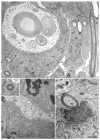The Structure of the Female Genital System of the Diving Beetle Scarodytes halensis (Fabricius, 1787) (Hydroporinae, Dytiscidae), and the Organization of the Spermatheca and the Spermathecal Gland Complex
- PMID: 36975967
- PMCID: PMC10053596
- DOI: 10.3390/insects14030282
The Structure of the Female Genital System of the Diving Beetle Scarodytes halensis (Fabricius, 1787) (Hydroporinae, Dytiscidae), and the Organization of the Spermatheca and the Spermathecal Gland Complex
Abstract
The fine structure of the female reproductive organs of the diving beetle Scarodytes halensis has been described, with particular attention to the complex organization of the spermatheca and the spermathecal gland. These organs are fused in a single structure whose epithelium is involved in a quite different activity. The secretory cells of the spermathecal gland have a large extracellular cistern with secretions; duct-forming cells, by their efferent duct, transport the secretions up to the apical cell region where they are discharged into the gland lumen. On the contrary, the spermatheca, filled with sperm, has a quite simple epithelium, apparently not involved in secretory activity. The ultrastructure of the spermatheca is almost identical to that described in a closely related species Stictonectes optatus. Sc. halensis has a long spermathecal duct connecting the bursa copulatrix to the spermatheca-spermathecal gland complex. This duct has a thick outer layer of muscle cells. Through muscle contractions, sperm can be pushed forwarding up to the complex of the two organs. A short fertilization duct allows sperm to reach the common oviduct where eggs will be fertilized. The different organization of the genital systems of Sc. halensis and S. optatus might be related to a different reproductive strategy of the two species.
Keywords: diving beetles; female reproductive system; insect ultrastructure.
Conflict of interest statement
The authors declare no conflict of interest.
Figures







References
-
- Pattarini J.M., Starmer W.T., Bjork A., Pitnick S. Mechanisms underlying the sperm quality advantage in Drosophila melanogaster. Evolution. 2006;60:2064–2080. - PubMed
LinkOut - more resources
Full Text Sources

